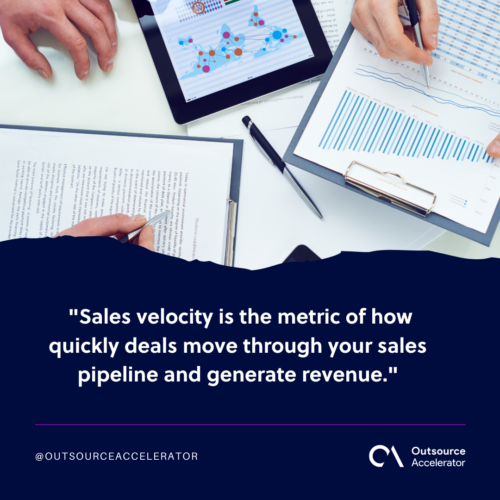What is sales velocity?

Imagine you’re at the wheel of a high-performance car and want to go from zero to sixty in record time. What do you do? You press on the gas pedal and unleash your engine’s full power.
In the sales world, the equivalent of that gas pedal is known as “sales velocity.” Like stepping on the gas, understanding and optimizing it can propel your business to new heights.
In this article, we’ll break down what sales velocity is, why it matters, and how you can harness it to boost your business growth.
Sales velocity defined
Sales velocity is the metric of how quickly deals move through your sales pipeline and generate revenue.
It’s all about the speed of your sales cycle — from the moment a lead enters your pipeline to when they become a paying customer.
In simple terms, sales velocity is the rate at which you turn potential into profit.

Why is sales velocity important?
Understanding your sales velocity is vital for several reasons:
Revenue forecasting
Sales velocity provides insights into how quickly your sales team can generate revenue.
By analyzing historical data and current momentum, you can forecast future revenues and adjust your business strategy accordingly.
Identifying bottlenecks
Sales velocity helps identify bottlenecks in your sales process. If leads stagnate at a particular stage for an extended period, it indicates a problem that must be addressed.
In fact, Ricochet360 found that 75% of potential customers do business with a company that initiates contact with them first.
Therefore, pinpointing bottlenecks allows you to optimize your sales process for increased efficiency and higher conversion rates.
Optimizing resource allocation
With sales velocity, you can determine which parts of your sales process contribute the most to your bottom line.
By focusing on the stages and activities that bring the highest acceleration, you can allocate resources more effectively and improve overall performance.

Improving sales rep performance
Sales velocity can also help you assess individual sales rep performance. By analyzing the velocity of each salesperson, you can:
- Identify top performers
- Determine areas where additional training is needed
- Provide targeted coaching to improve overall team performance
Factors affecting sales velocity
Sales velocity isn’t a one-size-fits-all metric. Several factors can influence it, including:
1. Sales cycle length
Faster sales cycles lead to increased sales speed. Streamlining your sales process, reducing friction, and eliminating unnecessary steps can significantly impact your momentum.
2. Win rate
A higher win rate means more leads progressing through the pipeline, increasing the sales momentum. Improve your win rate by refining your targeting, qualifying leads effectively, and crafting compelling value propositions.
3. Average deal size
Larger deals contribute to higher sales acceleration. You can increase the average deal size by focusing on upselling and cross-selling opportunities, client satisfaction, and building trust.
4. Lead quality
High-quality leads that align with your target market and fit your ideal customer profile will progress more smoothly through the sales pipeline. This positively impacts sales velocity.
How to calculate sales velocity
Sales velocity can be calculated using a simple formula:
Sales Velocity = No. of Opportunities x Win Rate x Avg. Deal Value ÷ Sales Cycle Length
For example, let’s say you have 100 opportunities, a win rate of 30%, an average deal size of $5000, and an average sales cycle length of 60 days.
The computation would be:
Sales velocity = 100 x 0.30 x $5000 ÷ 60 = $15,000
This means that, on average, your sales team generates $15,000 in daily revenue.
Tips for increasing sales velocity
Ready to rev up your sales velocity? Here are some practical tips:
- Improve lead quality. Focus on attracting leads more likely to convert into customers.
- Streamline your sales process. Eliminate bottlenecks and unnecessary steps that slow things down.
- Shorten sales cycles. Identify opportunities to speed up the journey from lead to customer.
- Train and motivate your sales team. Invest in your team’s skills and motivate them to close deals efficiently.
- Leverage technology. Utilize sales automation tools, CRM systems, and analytics to streamline processes, track progress, and identify areas for improvement.
- Enhance customer experience: Enhance the buying journey by understanding customer pain points, addressing objections, and personalizing interactions.
- Optimize pricing. Detect the sweet spot between profitability and competitive pricing.

Achieving growth with sales velocity
Sales velocity isn’t just a metric — it’s the engine that powers your business growth.
Regularly analyzing and monitoring it allows you to identify areas for improvement, refine your sales strategies, and turn leads into customers at an accelerated pace.
Understanding and optimizing this critical aspect of your sales process can boost your journey to success.
Just like a skilled driver at the wheel of a high-performance car, you’ll be able to navigate the sales landscape with confidence and speed. So, step on the gas, embrace sales velocity, and watch your business thrive.







 Independent
Independent




